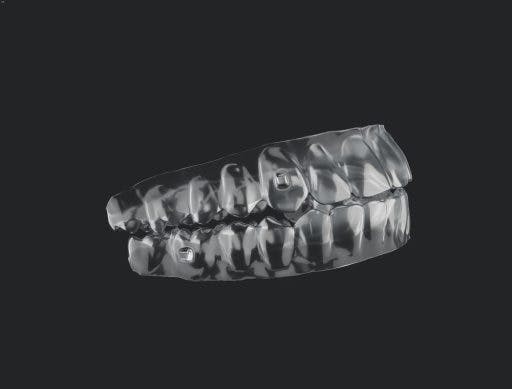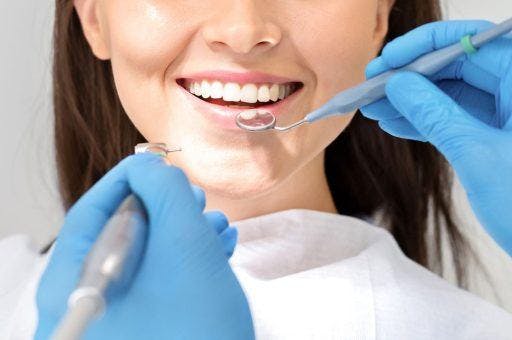If you’ve been looking into aligner therapy, you may have seen the term “aligner attachments“ in discussion forums. But what exactly are they? Do you really need them for effective treatment, and will they affect the discreetness of your aligners? Read on for the lowdown.
What are aligner attachments?
Aligner attachments, also known as engagers or buttons, affix to teeth and serve as anchors that assist the appliance with certain movements. You can think of them as add-ons for treatment – not everyone needs them, but they can be incredibly beneficial for those who do.
How aligner attachments help with treatment

Attachments consist of the same composite resin material that dentists use for dental fillings and other similar treatments. While they function similarly to brackets on braces, they’re much smaller and less visible. Dental practitioners use attachment materials like acid etch, pastes, and bonding agents to secure them to teeth. Once fixed, you can hook your clear aligners onto the attachments.
Aligner attachments don’t compromise the fit and general comfort of your aligners. Do you think you might need them? Here are a few ways they can help improve your orthodontic treatment.
1. Attachments provide more control for challenging movements.
Straightforward movements are easy to achieve with clear aligner trays only. However, more complex ones, such as rotations (turning a tooth in its socket), require clear aligner attachments.
They give the orthodontic appliance something to engage with and provide additional force for more controlled pushing, pulling, or rotating. Some teeth misalignment cases that might require tooth rotation include overcrowding, crossbites, and overbites.
2. Attachments make progress smoother and more predictable.
The International Journal of Environmental Research and Public Health published a review of existing studies and found that “[all studies] indicate better control and a higher range of tooth movement […] with attachments than without attachments.”
This higher degree of control means that teeth are more likely to move into their proper positions following your treating dentist’s projections. In the end, you get more predictable results and timely progress. Translation – fewer surprises!
3. Attachments enable aligners to grip and move irregular teeth.
Clear aligners consist of a flexible plastic material, which makes them comfortable. However, that flexibility can limit how much force aligners can apply, especially when a tooth has an irregular shape, size, or position. Attachments create a uniform contact point for aligners to grip, allowing for more consistent force application.
What to expect when getting aligner attachments

The only way to know if you need attachments is to discuss them with your dentist, who will perform exams to determine how to approach your case.
Your dentist might propose attachments during the planning phase.
This is also the best time to express your goals and preferences. If you strongly oppose attachments, your dentist may offer alternatives like cutouts with elastics and other auxiliaries.
Attachments are generally nondisruptive, but they still have a few downsides.
Since attachments sit on a tooth’s surface, they attract plaque – so you need to pay extra attention to the affected areas to prevent tooth decay. They’re not removable, so you can’t pop them off during meals. This can lead to visible staining and discolouration, especially if you consume dark-coloured foods or drinks. If these are dealbreakers for you, you should discuss other options and your concerns with your dentist.
They come in different shapes, sizes, and designs, depending on the brand.
ClearCorrect offers two main types in their setups: vertical and horizontal. Attachments also vary in size from two to four millimetres. Your dentist will decide what’s right for you based on your condition.
To know if you’re a candidate for ClearCorrect aligners, take this online smile assessment.
They’re much more discreet than clear brackets on braces.
Attachments are typically small and tooth-coloured or transparent. As such, they won’t interfere with the subtle appearance of clear aligners. They’re barely visible even without the appliance on top.
They’re a semipermanent feature, but not foolproof.
Since aligner attachments bond to teeth, you won’t be able to remove them without the help of your dentist. Otherwise, you risk damaging your enamel. But sometimes, attachments can fall off or become loose. It can happen when chewing on hard foods or brushing your teeth too vigorously. It helps to be mindful of your oral care habits. Ask your dentist about adjustments if your aligners frequently dislodge.
They only work in conjunction with aligners.
Attachments can’t address misalignment on their own. You’ll still need to wear your appliance for at least 22 hours daily for optimal effectiveness. Remember – neglecting your wear schedule can prolong your treatment and compromise your results.
Aligner attachments can enable more controlled and consistent orthodontic treatment, especially for complex teeth misalignment. Talk to your dentist to determine if they should be part of your plan.
Reference:
Jedliński, M., Mazur, M., Greco, M., Belfus, J., Grocholewicz, K., & Janiszewska-Olszowska, J. (2023). Attachments for the Orthodontic Aligner Treatment—State of the Art—A Comprehensive Systematic Review. International Journal of Environmental Research and Public Health, 20(5), 4481.



